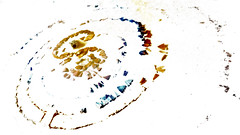The miracle of resurrection is (on a microscopic level) the re-arranging of particles, animated along a form that reflects the glory of the Force that moves them into position. At Easter, Jesus’ grave cloths, folded neatly in a pile (off to one side) communicate an orderly intentionality about the whole resurrection event that says: I have risen: and the rest of the world, in the wake of this moment, also begins to re-organize, after the Will of the Animator. The Animator has re-animated.
My own re-animations are cheap imitations: the work of a mere creature. But even of such lowly worms as you and I, God moulds his purpose. He reclaims our weaknesses for His glory. The detritus of these spent art materials, then, can also be reclaimed, reorganized, and revitalized, so that they once again become useful: elements in a story, parts of some bigger galaxy. And so my use of weak vessels in my art, my working to redeem their qualities, and re-direct their purposes, points to and mirrors the way in which God uses us. Atheist philosopher Bertrand Russell claims that "unless you assume a God,the question of life’s purpose is meaningless." On the flip side – though Lyotard may be incredulous – once assume a God, you’ll also be empowered to assume your place in his meta-narrative.
